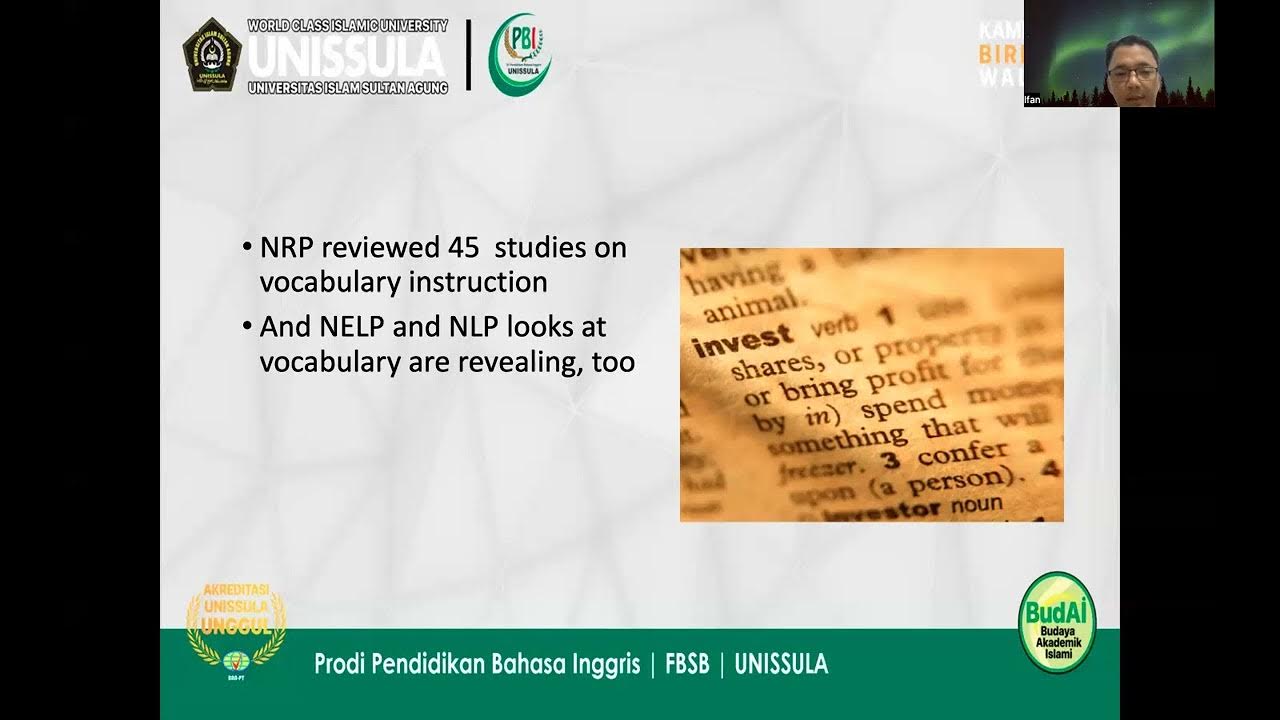Innovative Strategies to Teach Reading👩🏫📖
Summary
TLDRThis presentation focuses on innovative strategies for teaching reading skills. It covers essential topics such as methods to introduce reading, teaching materials, engaging activities, and effective assessment strategies. Key methods discussed include intensive reading, task-based language teaching, and competency-based learning. Engaging activities like jigsaw reading, story strip puzzles, and choice-based reading are highlighted to keep students motivated. Additionally, the presentation explores formative and performance-based assessments, strategy-specific assessments, and the use of technology for real-time feedback. The overall goal is to enhance students' reading comprehension and literacy development through diverse, interactive, and contextually relevant strategies.
Takeaways
- 😀 Innovative strategies are essential for teaching reading skills effectively.
- 😀 Teaching reading involves developing skills like skimming, scanning, predicting, and inferring.
- 😀 Intensive reading methods focus on comprehension and accuracy, encouraging deep engagement with short texts.
- 😀 Task-Based Language Teaching (TBLT) integrates reading with real-world tasks, making reading more contextual and goal-oriented.
- 😀 Competency-Based Language Teaching (CBLT) emphasizes achieving measurable competencies in reading while enhancing critical thinking skills.
- 😀 Engaging activities like jigsaw reading and reading dice games make reading fun and interactive for students.
- 😀 Story strip puzzles promote collaboration and critical thinking by helping students understand text structure.
- 😀 Offering students choices in reading materials helps foster their interest and engagement in reading activities.
- 😀 Formative assessments like anecdotal records and exit slips help teachers monitor real-time student progress in reading.
- 😀 Performance-based assessments such as project-based learning and digital storytelling allow students to demonstrate practical application of reading strategies.
Q & A
What is the main goal of teaching reading skills?
-The main goal of teaching reading skills is to improve students' ability to understand and interpret authentic texts, enhancing their critical thinking skills, vocabulary, and understanding of language structures used in different types of text.
What are some pre-reading skills mentioned in the presentation?
-Some pre-reading skills mentioned include skimming, scanning, reading for detail, inferring, predicting, guessing meaning from context, identifying the main idea, and spotting details.
How does the intensive reading method contribute to reading skills?
-The intensive reading method involves students reading a short text very carefully and in detail, focusing on understanding vocabulary, grammar, and meaning. It emphasizes accuracy and comprehension, often with the use of dictionaries or translations.
How does Task-Based Language Teaching (TBLT) help in teaching reading skills?
-TBLT encourages students to engage in reading activities that are contextual and goal-oriented. By completing assignments such as summarizing a text or analyzing its structure, students develop a deeper understanding of the material and its relevance.
What is the focus of Competency-Based Language Teaching (CBLT) in reading instruction?
-CBLT emphasizes the achievement of specific competencies, tailoring reading activities to real-life needs. It encourages students to apply information from the text in decision-making, promoting critical and analytical thinking.
What is jigsaw reading and how does it enhance student engagement?
-Jigsaw reading is a collaborative activity where students are given different parts of a story to read and later share with their group. This activity promotes understanding, encourages creativity, and helps stimulate critical thinking.
How does the reading dice game (Roll and Tell) work, and what is its purpose?
-In the reading dice game, students roll a dice where each number corresponds to a different task or question related to the reading. The activity is designed to reinforce reading comprehension in a fun and interactive way.
What is a story strip puzzle, and how does it help students?
-A story strip puzzle involves cutting a story into individual sentences that students must rearrange into the correct order. This helps students understand the structure and storyline while promoting collaboration and critical thinking.
Why is giving students choices in reading materials beneficial?
-Allowing students to choose their reading materials, such as books or topics of interest, fosters a sense of autonomy, increases engagement, and encourages students to take ownership of their learning. It also leads to more meaningful discussions.
What are formative assessments, and how do they support reading instruction?
-Formative assessments are used during instruction to track students' progress in real-time. Examples include anecdotal records, exit slips, think-alouds, and reading journals, which help teachers adjust instruction to meet students' needs.
How does technology help in assessing reading progress?
-Technology tools like reading apps (e.g., Red Theory, Epic), digital storytelling platforms (e.g., Canva, Book Creator), and interactive quizzes (e.g., Kahoot) provide quick feedback, track progress, and engage students creatively while assessing their comprehension and reading strategies.
Outlines

This section is available to paid users only. Please upgrade to access this part.
Upgrade NowMindmap

This section is available to paid users only. Please upgrade to access this part.
Upgrade NowKeywords

This section is available to paid users only. Please upgrade to access this part.
Upgrade NowHighlights

This section is available to paid users only. Please upgrade to access this part.
Upgrade NowTranscripts

This section is available to paid users only. Please upgrade to access this part.
Upgrade Now5.0 / 5 (0 votes)





